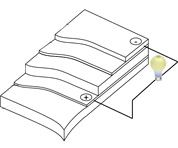

Thin Films Photovoltaics
Photovoltaic solar cells produce electricity from sunlight. Today, most solar cells are made from rigid multi-crystalline silicon (Si) wafers that are typically 150 µm thick. To create solar cells, these wafers must go through several processing steps and then be integrated into a module. High material and processing costs make Si-based modules relatively expensive.Thin-film solar cells are potentially lower cost alternatives to Si-based devices because of their comparatively lower processing and materials costs. Thin film solar cells utilize only a 1–4 µm thick layer of semiconducting material to produce electricity. Devices that employ flexible substrates have an additional advantage in advanced applications such as Building Integrated Photovoltaics (“BIPV”) since they can be packaged in flexible and lightweight structures.
Today, three primary types of thin-film solar cells have been commercially developed: amorphous silicon (a-Si), cadmium telluride (CdTe) and copper-indium-gallium-selenide (CIGS) based devices. The following chart compares the traditional advantages and disadvantages of these technologies:
Technology |
Maximum Demonstrated Efficiency for small cells* |
Advantages |
Disadvantages |
a-Si |
12.2% |
|
|
CdTe |
16.5% |
|
|
CIGS |
19.9% |
|
|
* Confirmed by third party measurements.
CIGS-based solar cells have the highest demonstrated conversion efficiency. Manufacturing cost of CIGS cells, however, has traditionally been high. SoloPower’s proprietary approach embodies critical technology, manufacturing, and cost advantages that overcome these challenges and enable large-scale production.